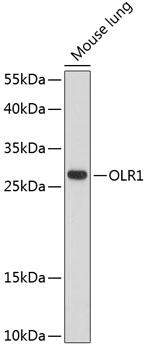Anti-OLR1 Antibody (CAB12060)
- SKU:
- CAB12060
- Product type:
- Antibody
- Reactivity:
- Mouse
- Host Species:
- Rabbit
- Isotype:
- IgG
- Antibody Type:
- Polyclonal Antibody
- Research Area:
- Cell Biology
Frequently bought together:
Description
| Antibody Name: | Anti-OLR1 Antibody |
| Antibody SKU: | CAB12060 |
| Antibody Size: | 20uL, 50uL, 100uL |
| Application: | WB |
| Reactivity: | Mouse |
| Host Species: | Rabbit |
| Immunogen: | A synthetic peptide corresponding to a sequence within amino acids 1-100 of human OLR1 (NP_002534.1). |
| Application: | WB |
| Recommended Dilution: | WB 1:500 - 1:1000 |
| Reactivity: | Mouse |
| Positive Samples: | Mouse lung |
| Immunogen: | A synthetic peptide corresponding to a sequence within amino acids 1-100 of human OLR1 (NP_002534.1). |
| Purification Method: | Affinity purification |
| Storage Buffer: | Store at -20°C. Avoid freeze / thaw cycles. Buffer: PBS with 0.02% sodium azide, 50% glycerol, pH7.3. |
| Isotype: | IgG |
| Sequence: | MTFD DLKI QTVK DQPD EKSN GKKA KGLQ FLYS PWWC LAAA TLGV LCLG LVVT IMVL GMQL SQVS DLLT QEQA NLTH QKKK LEGQ ISAR QQAE EASQ ESEN |
| Gene ID: | 4973 |
| Uniprot: | P78380 |
| Cellular Location: | Cell membrane, Lipid-anchor, Membrane raft, Secreted, Single-pass type II membrane protein |
| Calculated MW: | 20kDa/21kDa/30kDa |
| Observed MW: | 31kDa |
| Synonyms: | OLR1, CLEC8A, LOX1, LOXIN, SCARE1, SLOX1 |
| Background: | This gene encodes a low density lipoprotein receptor that belongs to the C-type lectin superfamily. This gene is regulated through the cyclic AMP signaling pathway. The encoded protein binds, internalizes and degrades oxidized low-density lipoprotein. This protein may be involved in the regulation of Fas-induced apoptosis. This protein may play a role as a scavenger receptor. Mutations of this gene have been associated with atherosclerosis, risk of myocardial infarction, and may modify the risk of Alzheimer's disease. Alternate splicing results in multiple transcript variants. |
| UniProt Protein Function: | OLR1: Receptor that mediates the recognition, internalization and degradation of oxidatively modified low density lipoprotein (oxLDL) by vascular endothelial cells. OxLDL is a marker of atherosclerosis that induces vascular endothelial cell activation and dysfunction, resulting in pro-inflammatory responses, pro- oxidative conditions and apoptosis. Its association with oxLDL induces the activation of NF-kappa-B through an increased production of intracellular reactive oxygen and a variety of pro- atherogenic cellular responses including a reduction of nitric oxide (NO) release, monocyte adhesion and apoptosis. In addition to binding oxLDL, it acts as a receptor for the HSP70 protein involved in antigen cross-presentation to naive T-cells in dendritic cells, thereby participating in cell-mediated antigen cross-presentation. Also involved in inflammatory process, by acting as a leukocyte-adhesion molecule at the vascular interface in endotoxin-induced inflammation. Also acts as a receptor for advanced glycation end (AGE) products, activated platelets, monocytes, apoptotic cells and both Gram-negative and Gram- positive bacteria. Independent association genetic studies have implicated OLR1 gene variants in myocardial infarction susceptibility. OLR1 may be involved in Alzheimer disease (AD). Involvement in AD is however unclear: according to some authors (PubMed:12354387, PubMed:12810610 and PubMed:15976314), variations in OLR1 modify the risk of AD, while according to other (PubMed:15000751 and PubMed:15060104) they do not. 2 isoforms of the human protein are produced by alternative splicing. |
| UniProt Protein Details: | Protein type:Membrane protein, integral; Receptor, misc. Chromosomal Location of Human Ortholog: 12p13.2-p12.3 Cellular Component: nucleoplasm; membrane; intracellular membrane-bound organelle; integral to plasma membrane; plasma membrane; receptor complex; lipid raft Molecular Function:low-density lipoprotein receptor activity; protein binding; carbohydrate binding Biological Process: cell death; receptor-mediated endocytosis; leukocyte adhesion; response to hydrogen peroxide; blood circulation; lipoprotein metabolic process; inflammatory response; proteolysis; blood coagulation; leukocyte migration Disease: Myocardial Infarction, Susceptibility To |
| NCBI Summary: | This gene encodes a low density lipoprotein receptor that belongs to the C-type lectin superfamily. This gene is regulated through the cyclic AMP signaling pathway. The encoded protein binds, internalizes and degrades oxidized low-density lipoprotein. This protein may be involved in the regulation of Fas-induced apoptosis. This protein may play a role as a scavenger receptor. Mutations of this gene have been associated with atherosclerosis, risk of myocardial infarction, and may modify the risk of Alzheimer's disease. Alternate splicing results in multiple transcript variants.[provided by RefSeq, Feb 2010] |
| UniProt Code: | P78380 |
| NCBI GenInfo Identifier: | 73621335 |
| NCBI Gene ID: | 4973 |
| NCBI Accession: | P78380.1 |
| UniProt Secondary Accession: | P78380,Q2PP00, Q7Z484, A8K7V9, B4DI48, G3V1I4, |
| UniProt Related Accession: | P78380 |
| Molecular Weight: | 21,425 Da |
| NCBI Full Name: | Oxidized low-density lipoprotein receptor 1 |
| NCBI Synonym Full Names: | oxidized low density lipoprotein (lectin-like) receptor 1 |
| NCBI Official Symbol: | OLR1 |
| NCBI Official Synonym Symbols: | LOX1; LOXIN; SLOX1; CLEC8A; SCARE1 |
| NCBI Protein Information: | oxidized low-density lipoprotein receptor 1; hLOX-1; ox LDL receptor 1; lectin-type oxidized LDL receptor 1; scavenger receptor class E, member 1; C-type lectin domain family 8 member A; oxidized low-density lipoprotein receptor 1, soluble form |
| UniProt Protein Name: | Oxidized low-density lipoprotein receptor 1 |
| UniProt Synonym Protein Names: | C-type lectin domain family 8 member A; Lectin-like oxidized LDL receptor 1; LOX-1; Lectin-like oxLDL receptor 1; hLOX-1; Lectin-type oxidized LDL receptor 1Cleaved into the following chain:Oxidized low-density lipoprotein receptor 1, soluble form |
| Protein Family: | Oxidized low-density lipoprotein receptor |
| UniProt Gene Name: | OLR1 |
| UniProt Entry Name: | OLR1_HUMAN |




